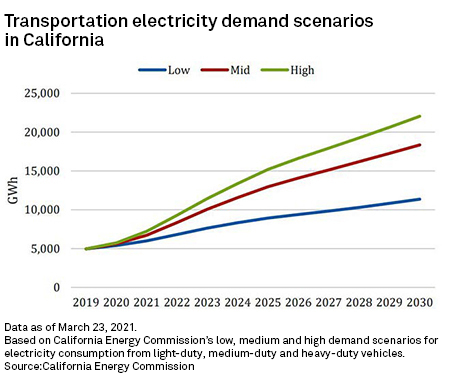S&P Global Offerings
Featured Topics
Featured Products
Events
S&P Global Offerings
Featured Topics
Featured Products
Events
S&P Global Offerings
Featured Topics
Featured Products
Events
Banking & Capital Markets
Economy & Finance
Energy Transition & Sustainability
Technology & Innovation
Podcasts & Newsletters
Banking & Capital Markets
Economy & Finance
Energy Transition & Sustainability
Technology & Innovation
Podcasts & Newsletters
S&P Global Offerings
Featured Topics
Featured Products
Events
24 Sep, 2021
Citing the "smashmouth realities of climate change," California Gov. Gavin Newsom on Sept. 23 signed two-dozen environmental and energy bills, including a landmark $15 billion package of investments to support zero-emission vehicles and combat wildfires, heat waves and drought.
"Something profound and extreme is happening, and it's happening decades before the scientists even believed it was going to happen," Newsom said amid falling ash at a media briefing held on the edge of a wildfire in Sequoia National Park.
California's eight-largest wildfires on record have all occurred since 2017, according to the state Department of Forestry and Fire Protection. That includes the 2021 Dixie Fire, now the state's second-biggest blaze, which has scorched nearly 1 million acres in the Sierra Nevada foothills.
Part of Newsom's broader "California Comeback Plan" in his state budget update, the outlays include $5.2 billion for measures related to water infrastructure and drought relief; $3.9 billion for zero-emission vehicles and infrastructure; and $3.7 billion for communities most exposed to climate change impacts like extreme heat and sea-level rise.
The package also carves out $1.5 billion for wildfire and forest management, and $1.1 billion to better align agricultural practices with a fast-changing climate.
The zero-emission vehicle spending enables customer rebates for new car purchases, funding for thousands of electrified and hydrogen-fueled trucks and buses, and electric vehicle charging and hydrogen refueling infrastructure.
Last year, Newsom signed an executive order to stop selling petroleum-fueled passenger vehicles in California by 2035. But a recent report from the California Energy Commission found the state needed to step up its build-out of EV infrastructure and integration of electric vehicles with the power grid.
California also has a strong economic incentive to support electric vehicles. "It's the number one export in the state of California. We want to dominate that future," Newsom said. It is not only Palo Alto-headquartered Tesla Inc.; nearly three dozen companies in the state are manufacturing EVs, according to the governor.
Around the world, automakers are investing hundreds of billions of dollars on EVs.
The state's largest electric utilities, global energy companies and a host of infrastructure upstarts are positioning for an expected jump in the electricity demand in the state from the transportation sector in coming years.

Emerging offshore wind, carbon removal strategies
The $15 billion funding package "represents the largest investment California, or any state, has ever made in the effort to stave off the most catastrophic impacts of climate change," Sen. Nancy Skinner, D-Berkeley, said in a statement. Skinner is chair of the state Senate's budget committee, which negotiated the investments with the Newsom administration and Assembly leaders as part of Senate Bill 170.
Newsom also signed Skinner's SB 27, which seeks to reduce and capture carbon emissions that have already been released, both through forests, wetlands and other natural means, as well as "cutting-edge technology like direct air capture that mimic this natural process," the senator said.
Among the other bills signed by Newsom was a measure directing state regulators to develop an offshore wind energy strategy. Assembly Bill 525 requires the Energy Commission, the state's primary energy policy agency, to establish offshore wind deployment targets for 2030 and 2045 by June 2022. The bill cites a 2021 joint state agency report that included 10,000 MW of offshore wind in a scenario for meeting the state's mandate for all retail power sales to be carbon free by 2045.
The measure comes after Newsom in May signed an agreement with administration officials for President Joe Biden to advance up to 4,600 MW of offshore wind projects in federal waters off the Golden State's northern and central coasts. Because of California's deep coastal waters, the state must rely on unique floating wind farms, a technology that has begun taking off in other parts of the world, particularly in Europe.
"Governor Newsom's signing of AB 525 marks an historic milestone and major turning point for California's offshore wind industry and workers," Adam Stern, executive director of the trade group Offshore Wind California, said in a statement.
